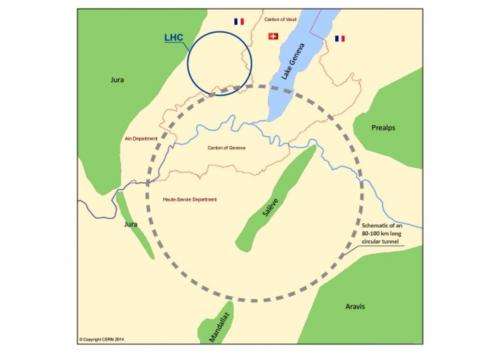Why bigger accelerators are better in particle physics

While the world's largest circular particle accelerator – the Large Hadron Collider (LHC) – will continue operation for the next few years, scientists have already started the conversation to build a much bigger, post-LHC circular accelerator.
A five-year feasibility study of the Future Circular Collider (FCC) was launched in a meeting of scientists earlier this month near Geneva, under the leadership of the European particle physics laboratory CERN, which hosts the LHC.
The proposed accelerator would be housed underground in an 80-100km tunnel – roughly four times longer than the existing LHC's 27km tunnel.
But what's the point of building a bigger version of what we already have? And with confirmation of the discovery of the Higgs boson last year, what's left to explore?
Designing the FCC
The modern powerful and high-energy experimental facilities are highly complex and technologically challenging to build, so require comprehensive studies before coming up with a final design.
Proposals for the current LHC began in the early 1980s but the machine wasn't actually completed and switched on until 2009. So while the LHC will continue to run experiments until around 2030 (or slightly beyond), now is the perfect time to start talking about its successor.
The FCC design study will have input from scientists across the globe from national laboratories, institutes and universities.
There are a few contenders to host the gigantic machine. The obvious front-runner is the CERN who is banking on the success of the LHC and their existing research and development accelerator infrastructures – but there is strong interest from Japan and China too.
If the machine is built in Geneva then the brand new tunnel will straddle the Switzerland-France border, go under Lake Geneva and kiss the Alps in the east and the Jura mountains in the west.
Deciding what to throw in the collider pot
The FCC would require to operate nearly an order of magnitude higher energy than the LHC, but this could be achieved with the assembly of different types of superconducting steering magnets to accelerate particles through the tunnel.
The total length of a collider's arc is measured by the number of the magnets and their strength. In a realistic scenario, if the FCC's magnetic system were to provide a magnetic field of 16 Tesla (maximum 20 Tesla) – around twice the value of the LHC magnetic field – then we'd require the accelerator complex to have a circumference of 100km.
This assembly would accelerate the particles very close to the speed of light.
When the LHC switches on again next year we might get a peek at the secrets behind supersymmetry, dark matter or other exotic phenomena (all collectively known as the New Physics).
Those results would build a strong physics case for the FCC. There is tons of theoretical physics work that can only be confirmed or ruled out experimentally at higher energies (in other words, with faster acceleration and higher speeds).
There is open debate on the types of particles to smash together in the FCC:
- proton-proton (hadron collider) – needing roughly an order of magnitude higher energy than the LHC
- electron-positron (lepton collider) as a potential intermediate step towards realisation of the hadron facility. For this option, combining with the International Linear Collider – a proposed electron-positron 31km long linear collider – would also be considered
- electron-proton.
The LHC currently hosts seven experiments but it is probably too early to say how many experiments the FCC would host. In addition, there is no official funding number for this project yet. We might have to wait a little while for those figures, but the five-year study will provide cost and energy optimisation.
Colliders help us to understand the nature deeper and at a very minute level – and, with talks beginning now, they have the added benefit of galvanising industries to develop and provide cutting edge technologies.
If the post-LHC circular collider becomes a reality then it will easily snatch the title of The Lord of the Particle Ring from the LHC.
Provided by The Conversation
This story is published courtesy of The Conversation (under Creative Commons-Attribution/No derivatives).![]()



















